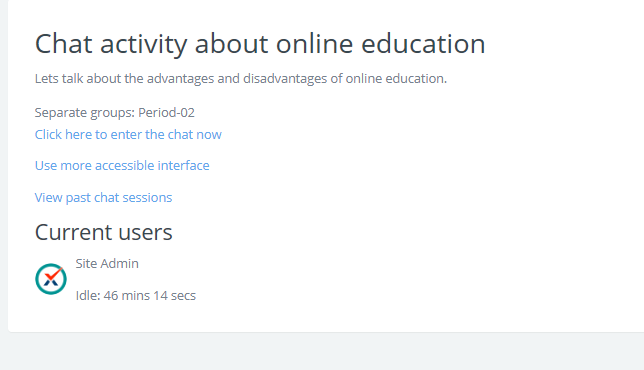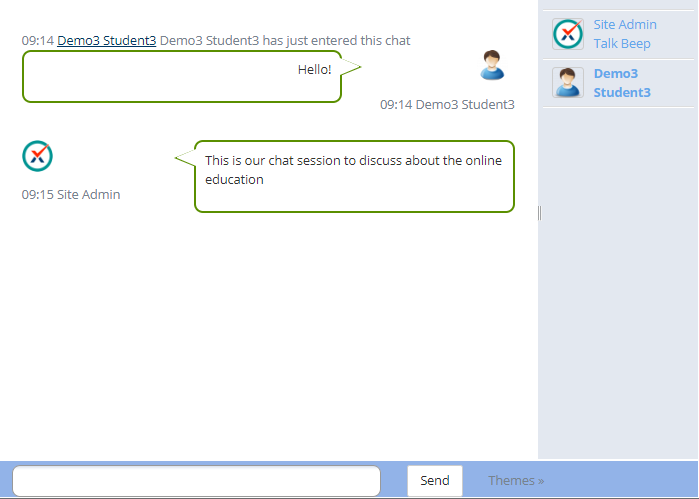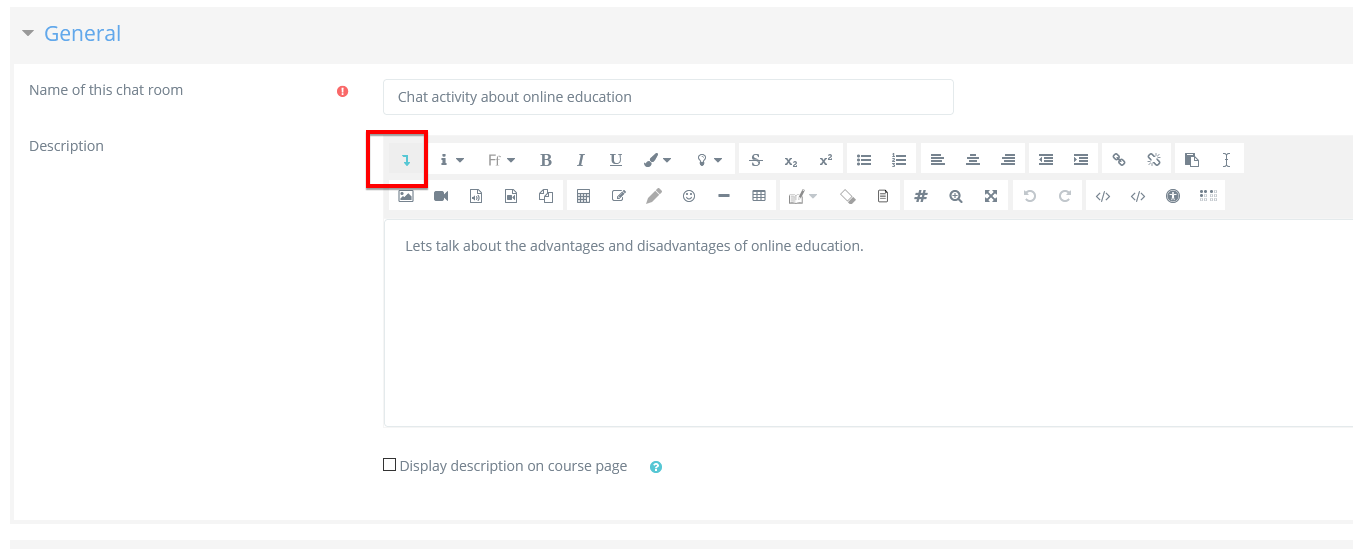Chat activity
Adding a Chat to your course
- With the editing turned on, in the section you wish to add your chat, click the "Add an activity or resource" link (or, if not present, the "Add an activity" drop down menu ) and choose Chat All settings may expanded by clicking the "Expand all" link top right.
General
|
Name of this chat room
- Whatever you type here will form the link students click on to enter the chat so it is helpful to give it a name that suggests its purpose - for example "Online education discussion" or "Book discussion".
Description
Type the description of the chat here. Include precise instructions for students regarding the subject of the chat. Click the icon on the left to expand the toolbar, and drag the bottom right of the text box out to expand it.
Display description on course page
If this box is ticked, the description will appear on the course page just below the name of the Chat.
Chat sessions
(These settings are collapsed by default.)
|
Next chat time
- The day and hour of the next chat session. This will appear in the calendar so students know the schedule but it doesn't stop them accessing the chatroom at any other time.
- If you don't want them in the chatroom at other times, then hide it (with the eye icon) or use "Restrict Access" to restrict access based on dates.
- If you don't wish to schedule chat times then ignore this and choose from the next settings.
Repeat/publish sessions
- There are four options for scheduling future chat sessions:
- Don't publish any chat times- there are no set times and students are welcome to chat at any time.
- No repeats - publish the specified time only- only the Next chat time will be published. This could be used to schedule special events or meetings or simply to help students identify a common time in which they can expect to find other students in the chat room.
- At the same time every day- Daily chats are useful for scheduling daily office hours or work sessions with students.
- At the same time every week--This setting will schedule a chat for the same day and time every week, which could be useful for instance for meeting and reviewing key ideas and questions related to the week’s content/assessment.
Save past chat sessions
- Choose from the dropdown how many days to save - or save everything by selecting Never delete messages
- If you have any concerns about discussions that might take place in your chat room, you may want to keep transcripts to check the suitablility of what is discussed. If your students are using the chatroom to collaborate on a group project you won't want to delete the messages until the project is complete.
Everyone can view past sessions
- Decide here whether or not allow everyone to view past chat sessions. (Teachers can always view past sessions)
Entering the chat

- As you click the chat link on the course page you see two or three options:
- Click here to enter the chat now - this takes you to the chat using the chosen site default chat method.
- Use more accessible interface - this gives a simpler chat room without frames and javascript:
- View past sessions - if this has been enabled and the user is allowed to view past chat sessions, this takes them to a list of past sessions with links to the chat.
Joining in a chat session
- In normal view, the screen is in two parts with the participants on the right, the messages on the left and a box at the bottom into which users type their message and press "Send" to make their contribution:
- Users can change the appearance of the messages by clicking on "Themes" next to the "Send" button. Alongside the default course theme, there are two other available themes: 'Bubbles' and 'Compact'.

The chat module contains some features to make chatting a little nicer.
Smilies Any smiley faces (emoticons) that you can type elsewhere in the site can also be typed in here and they will be displayed correctly.
Links Internet addresses will be turned into links automatically.
Emoting You can start a line with /me to emote. For example, if your name is Kim and you type /me laughs! then everyone will see "Kim laughs!"
Beeps You can send a sound to other people by hitting the "beep" link next to their name. A useful shortcut to beep all the people in the chat at once is to type "beep all". Safari users may need to allow sounds for the specific site. Linux users may require a browser plugin to be installed to play sounds.
Talk If you click the 'Talk' link by a person's name, it will then add their name in the chat box to show your message is directed at that particular person, such as: 'Mary said to Brian Franklin...'
HTML If you know some HTML code, you can use it in your text to do things like insert images, play sounds or create different colored and sized text.
Chat reports
- To view previous chats (if you have permission) click on the 'View past chat sessions' link.
Teachers can also access past chat sessions from the "Chat" drop-down menu on top menu bar.
- This will bring up a listing of each chat session under the current chat topic. The listings include the time the chat started and ended, which users participated, and how many messages each user sent. Individual sessions may be deleted by clicking the 'Delete' link.
Clicking on 'See this session' will display a transcript of that particular chat:
Chat transcript
- In order for students to see past sessions, the teacher or an administrator must setup the chat to allow everyone to view past chat sessions. Please refer to the Chat settings section.
Why use chat?
- Chat has an advantage over a Forum in that it takes place in Real Time. It is especially beneficial when the group chatting is not able to meet face to face. Examples might be:
- Regular meetings of staff on large or split campuses to discuss student or curriculum issues;
- Regular meetings of students doing online courses to enable them to share experiences with others on the same course but potentially in a different city (or country)
- A teacher working with his students even though he is out of school
- A student temporarily unable to attend in person chatting with their tutor to catch up with work.
- Students out on work experience getting together to discuss their experiences with each other and their tutor
- Younger children using chat at home in the evenings as a controlled(monitored) introduction to the world of social networking
Why NOT use chat?
- Unless a tutor/moderator is permanently present in the chatroom -or unless the chat is hidden and revealed at certain times, it is difficult to control what is said once a chat has started.
- Younger students particularly may find it difficult to stay on task and be prone to adding non-useful comments or "beeping" others for the sake of it.
- In some situations, a forum might be preferred as it allows for reflection before posting and gives a period of time where the post might be edited.


